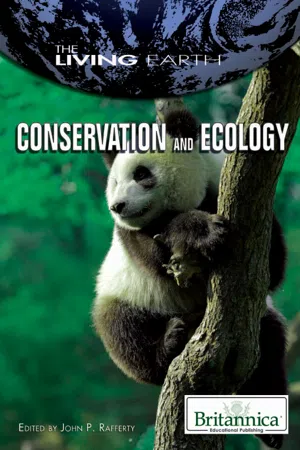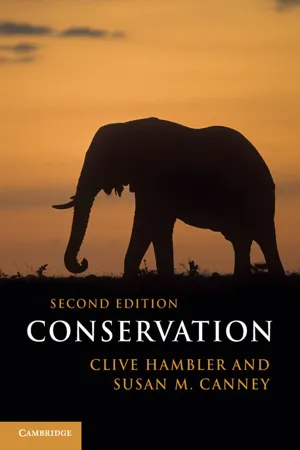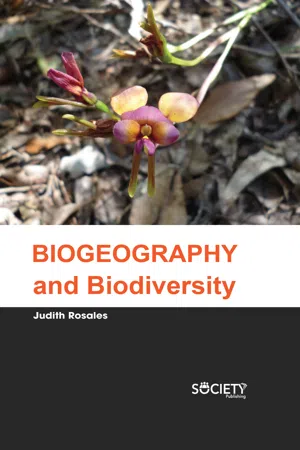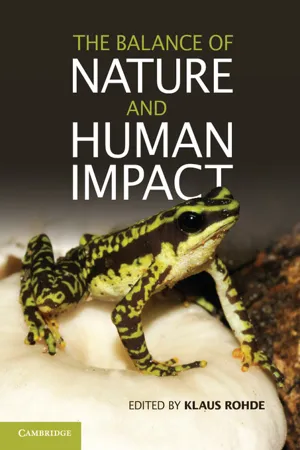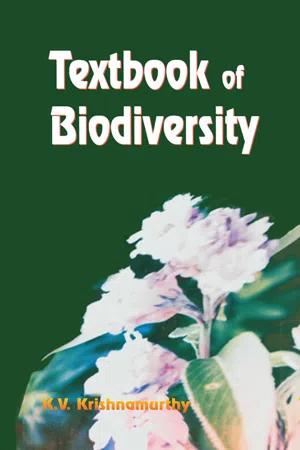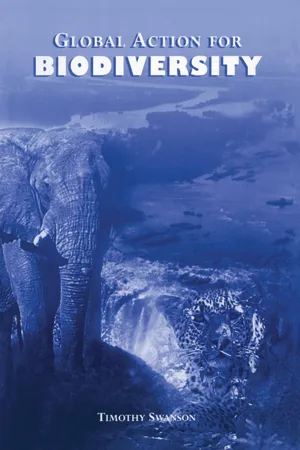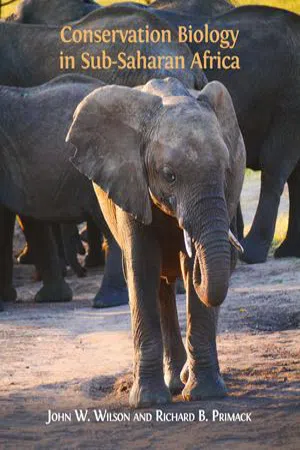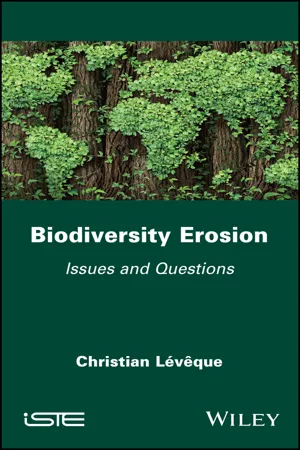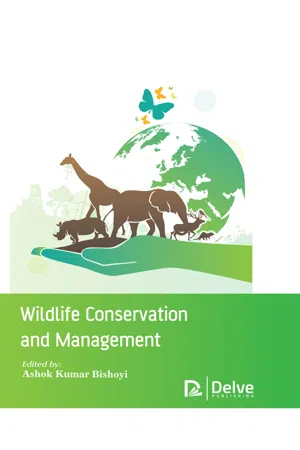Biological Sciences
Causes of Extinction
Causes of extinction refer to the factors that lead to the permanent disappearance of a species. These can include natural events such as climate change, geological events, and competition with other species, as well as human-induced factors like habitat destruction, pollution, and overhunting. Understanding these causes is crucial for conservation efforts and the preservation of biodiversity.
Written by Perlego with AI-assistance
Related key terms
1 of 5
11 Key excerpts on "Causes of Extinction"
- eBook - ePub
- Britannica Educational Publishing, John P Rafferty(Authors)
- 2010(Publication Date)
- Britannica Educational Publishing(Publisher)
HE CAUSES OF EXTINCTIONI n theory, any factor capable of causing mortality can cause a species to die out if it is particularly intense and occurs over a wide geographic scale. Habitat loss, pollution, overharvesting, secondary extinctions, and global change may contribute to the demise of a species either singly or in concert with one another. The species most vulnerable to these phenomena include rare species, species that possess small home ranges, species whose mating systems result in inbred populations, and species that do not disperse widely.HABITAT LOSS
As mentioned above, habitat loss is widely listed as the predominant cause of extinction. It is not hard to understand why—clear a forest, destroy a coral reef, or dam a river, and the species found there will likely be lost. These are instances of local extinctions, however, and their occurrence does not mean that the species involved will go extinct everywhere, as is the situation for the global extinctions discussed in the case histories above. Some scientists use the term extirpation for local extinctions, reserving extinction to mean global extinction. In this section on factors causing extinction, the term has the global meaning.EXTINCTION IN TERRESTRIAL ENVIRONMENTSIn the preceding case histories, the roles of habitat loss in extinction of species are fairly clear-cut. There are seeming counterexamples—Europe and eastern North America, for example—where human actions have extensively modified terrestrial habitats, yet these areas are not centres of extinction. Clearly, habitat destruction causes different numbers of extinctions in different places.ENDEMIC SPECIESTo learn what makes centres of human-caused extinctions special, one can ask what are their common features. Obviously, many of these places and their species are well known. The 17th-century Dutch artist Rembrandt van Rijn painted birds-of-paradise and marine cone shells gathered from the early European exploration of the Pacific, testifying to people’s fascination for attractive and interesting specimens from “exotic” locales. Victorians filled their cabinets with such curiosities—birds, mammals, marine and terrestrial snail shells, and butterflies—and painted tropical flowers and grew them in their hothouses. Yet the natural history of North America and Europe are also very well known. In fact, what is special about the places with so many extinctions is that each area holds a high proportion of species restricted to it. Scientists call such species endemics. - eBook - PDF
- Clive Hambler, Susan M. Canney(Authors)
- 2013(Publication Date)
- Cambridge University Press(Publisher)
2 Threats to biodiversity This chapter examines some of the main threats to biodiversity. Humans have caused extinctions and habitat alterations for over 45 000 years. We examine the importance of human population growth and of our consumption of resources such as energy, food, water and land. We also examine the problem of pollution, which occurs once the limited capacity of the environment to deal with waste is exceeded. We then turn to introduced species. Most species are threatened by several factors, some of which are not known. Threats can cause extinctions directly or can cause ‘secondary extinctions’ through environmental changes. The amount of extinction and habitat change that humans have caused during the Holocene (the 11 500 years since the last ice age) is increasingly apparent, as are some of the causes (Williams, 2006; Turvey, 2009). 2.1 Identifying causes of recent extinctions What has caused the rise in extinction rates? Very few extinctions have been observed, and it is often difficult to identify the cause of an extinction. It is hard to find and study the last individuals of a species, even if we know the species exists. The threats to individual species often have to be identified using detailed studies of their ecology (autecology), revealing their requirements and mortality from different causes at different ages and regions (Section 6.3). In order to identify important drivers of extinction, a standard terminology is being devel- oped (Salafsky et al., 2008; Hayward, 2009). This will permit threats to species to be listed in a consistent way, with a global perspective. We also need to distinguish between the proximate Causes of Extinction, such as land conversion, overhunting and pollution, and the underlying drivers of extinction, which encompass societal and cultural forces of population, politics and economics; and science and technology (Chapter 9). - eBook - PDF
- Judith Rosales(Author)
- 2019(Publication Date)
- Society Publishing(Publisher)
Seeing the present scenario, human activities have also become the major cause of the extinction of many animal species. The modern extinction of animal and plant species are chiefly due to habitat destruction as farming land expands and forests are cut-down, along with pollution, the introduction of alien species, as well as over fishing or hunting. When the population of organisms, normally species end in an area, the term is known as extinction. The death of the last individual of the group is generally considered as the extinction of particular group in the environment. Because a species’ latent range may be very large, determining this moment is difficult and is usually done retrospectively. Lazarus taxon is the phenomenon which ultimately is talked about in concern to the above; in this phenomenon, a species alleged extinct brusquely re-appears after a period of apparent absence. Several influences are driving an unparalleled rate of extinction of animal as well as plant species globally. Although extinction is a natural process, the rate at which current extinction is taking place is clearly not, and all scientific evidence indicates that the activities of mankind are the primary engine behind most recent and present extinction events. Some of the chief Causes of Extinction are: • Habitat Loss Destructive change to landscapes or environments, either through human processes (such as construction, deforestation, changing land use for agriculture, artificial land drainage etc.), or natural phenomena (such as floods, volcanoes, hurricanes etc.), is the single utmost danger to the biodiversity of Planet Earth, and the extreme cause of extinction in the world. The animal population will become extinct, when a plant or an animal does not have a habitat, and cannot adapt to a different environment. - eBook - PDF
- Klaus Rohde(Author)
- 2013(Publication Date)
- Cambridge University Press(Publisher)
A similar mechanism results from access roads which open new markets for trade and add value to the exploitation of certain species (e.g., Macdonald et al., 2012). A second reason promoting exploitation of declining species is economic subsidies. Here governments grant different types of aids to compensate the monetary loss associated with declining stocks, thus preventing social turmoil but further intensifying exploitation (Sumaila et al., 2008; Mora et al., 2009; Mora & Sale, 2011). Habitat loss Habitat loss could be defined as the process by which the area inhabited by a species is rendered functionally unsuitable to further sustain individuals of the species. The causes of habitat loss are diverse and include the expansion for agriculture and urban areas (Short & Burdick, 1996; Gaston et al., 2003), climate change (Thomas et al., 2004), sea- level rise and sedimentation (Valiela et al., 2001), pollution (Short & Burdick, 1996), roads (Rytwinski & Fahrig, 2012), and excessive tourism (Schlacher & Thompson, 2012), among others. As a reference, the expansion of agricultural land has been associated with a 25% decline of the world’ s bird numbers since pre-agricultural times (Gaston et al., 2003), whereas ongoing climate change is expected to make certain areas inhospitable “committing to extinction” between 15% and 37% of the world’ s birds by 2050 (Thomas et al., 2004). Individually, habitat loss is the third leading cause of extinction in animals, being the sole factor in 11% of extinctions and accounting for the current vulnerability of 21% of threatened animal species. Yet of the documented plant extinctions not one occurred for this reason alone and only ~4% of currently threatened plant species are so by the sole effect of habitat loss (Figure 17.1). - eBook - ePub
In Defense of the World's Most Despised Species
Why we love some species but hate most, and why it matters
- Ernest Small(Author)
- 2023(Publication Date)
- CRC Press(Publisher)
9 ExtinctionHow Biased Elimination of Species Endangers HumansDOI: 10.1201/9781003412946-9Introduction
Individual living things die, which is sad, but far sadder is the ending of entire species. Today, a frightening number of species are on their deathbeds. This chapter examines how the current extinction crisis is a threat not just to the world’s wild species but also to the future of humans.Natural Extinction
Very long time periods are defined in geology by the intervals between planetary-scale catastrophes in which a substantial portion of living species were exterminated, and life was forced to survive very difficult conditions. Barnosky et al. (2011) defined a mass extinction as an episode in which the Earth lost 75% of its species in a geologically short time. There have been at least five such episodes due to catastrophic geological events in the last half billion years (Figure 9.1 ). Most familiar is the Cretaceous-Paleogene transition 66 million years ago, generally acknowledged to have been caused by an asteroid which slammed into Earth. This resulted in a mass extinction, famously of most dinosaurs (Figure 9.2 ). Generally, however, conditions on the planet and the world’s biota change slowly, for example due to drift of continents over billions of years to different part of the Earth, related to plate tectonics. Over the 3.5 billion years of life on Earth, 4 billion species are estimated to have gone extinct, representing 99% of all that ever existed (Barnosky et al. 2011 ). Most of the time, extinction has been balanced by the evolution of new species (the average species lasting of the order of 10 million years).FIGURE 9.1 - eBook - PDF
- K V Krishnamurthy(Author)
- 2003(Publication Date)
- CRC Press(Publisher)
A mass extinction can be defined as an exceptional loss in biodiversity that is substantial in size and global in extent; it should also affect a broad range of taxonomic groups over very short periods of geologic time (Jablonski 1986; Meffe and Carroll 1994; Sepkosk 1988). Some of these mass extinction episodes were of short duration while others extended for at least several million years. Eight extinctions have been identified and grouped into five major mass extinctions: (i) Ashgillian (end Ordovician), (ii) Givetian, (iii) Frasnian and (iv) Famennian (all three, late Devonian), (v) Guadalupian and (vi) Dzhulfian (both, end Permian), (vii) Norian (end Triassic) and (viii) Maastrichtian (end Cretaceous) (Raup and Sepkoski 1982). Most species extinctions have been due to these mass extinctions. For example, during the mass extinction of the Permian-Triassic boundary 96% of all Earth's species at that time reportedly perished (Raup 1979b) The Norian (end Triassic) and Maastrichtian (late Cretaceous) extinctions were also substantial. (Sepkosk and Raup 1986). Processes Responsible for Species Extinction Two types of processes are fundamentally responsible for species extinction: (i) Deterministic processes or cause-and- effectrelationships: Examples: glaciation, deforestation, habitat fragmentation etc. In these processes, some essential components of ecosystems are removed while others, lethal to the ecosystem, are added. Deterministic events are either readily observed or easily detected (more details on these processes are given later). - (ii) Stochastic processes or chance events: Four types of stochastic processes are distinguished (Gilpin and Soul6 1986; Shaffer 1981, 1987). (a) Demographic uncertainty: This resulted from the effect of random events on the survival and reproduction of individuals in a finite population. In a small population of, say, less than 100 individuals, demographic uncertainty can be seen. - eBook - ePub
Global Action for Biodiversity
An International Framework for Implementing the Convention on Biological Diversity
- Timothy Swanson(Author)
- 2013(Publication Date)
- Routledge(Publisher)
2THE FUNDAMENTAL CAUSES OF BIODIVERSITY’S DECLINE : A BIO -ECONOMIC MODELHuman Depletion of Diversity: Past, Present, and FutureBiodiversity’s decline derives primarily from human interaction with biological resources. Humans evolved a mere four million years ago (on life’s timeline of four billion years or so). We existed as one component within the living system for most of the next four million years; however very recently (in the past ten millennia or so) we humans have placed ourselves outside of that system, and commenced the reshaping of the biological diversity that is arrayed ‘beneath ourselves’. During this period, the extinction process has become a primarily human-sourced phenomenon.Of course, extinction has always existed as a natural process as well. Studies of the fossil record show that the natural longevity of any species lies in the range of 1 to 10 million years. The threat to biological diversity arises when the rate of extinction of species far exceeds the rate of speciation. In these eras of ‘mass extinctions’ there is the potential for a threat to the entire global biology. In the distant past, so-called ‘deep time’, there have been a number of occasions of such mass extinctions. There are at least five occasions indicated in the fossil record during which over 50 per cent of the then-existing animal species were rendered extinct (Raup, 1988).Even averaging in these periods of mass extinctions, the natural rate of extinction over deep time appears to have been in the neighbourhood of 9 per cent of existing species per million years, or approximately 0.000009 per cent per year (Raup, 1988). That is, the current stock of biological diversity is the result of several billion years of mostly low frequency mutation and extinction. Mass extinction has been an infrequent occurrence, usually the result of some exogenous phenomenon such as a collision with a comet. - eBook - PDF
- W. Johnny Wilson, Richard Primack(Authors)
- 2019(Publication Date)
- Open Book Publishers(Publisher)
259 Chapter 8 | Extinction Is Forever rise of agriculture (12,000–15,000 years ago) and again during the Industrial Revolution (1760–1840), when fossil fuel usage and urbanisation became the norm. Now, many scientists recognise today’s new and distinct human-dominated geological epoch , the Anthropocene (Waters et al., 2015). One notable feature of the Anthropocene is that species extinctions are increasing at such rapid rates that many conservation biologists now recognise that we are also witnessing the beginnings of Earth’s sixth extinction episode (Barnosky et al., 2011; Ceballos et al., 2017). However, unlike previously, this extinction episode is caused by human activities rather than natural events. 8.1 What is Extinction? The term “extinct” has several nuances in conservation biology, and its meaning can vary somewhat depending on the context: • A species is globally extinct when no individuals of that species remains alive anywhere in the world. The bluebuck ( Hippotragus leucophaeus , EX) has been globally Extinct since the last individual was shot around 1800 (Kerley et al., 2009). • Four (possibly seven) species of cycad ( Encephalartos spp.)—ancient seed plants that were dominant in the age of the dinosaurs— are currently considered extinct in the wild ; in other words, they exist only in cultivation; in captivity; or another human-managed situation (IUCN, 2019). • A species is locally extinct , also called extirpated , when it is extinct in a part of its historic range but can still be found elsewhere in the world. Cheetahs ( Acinonyx jubatus , VU) once roamed throughout much of Africa, but are now extirpated in over 90% of their historical range (Durant et al., 2017). • A species is ecologically extinct (also called functionally extinct ) if it persists at such low numbers that its role in an ecosystem is negligible. - eBook - PDF
Biodiversity Erosion
Issues and Questions
- Christian Lévêque(Author)
- 2022(Publication Date)
- Wiley-ISTE(Publisher)
I would also point out that the five major mass extinctions have been identified in marine species. But on the continents we know – again, according to paleontologists – that climate change has affected the biosphere on many occasions, in all likelihood leading to major upheavals in biological diversity. Do we have the balance sheets to claim today that the human’s action is unprecedented? In these unfounded accusations against humankind, who will bring tangible proof of guilt or acquittal? In reality, the theme of biodiversity decline is the hobbyhorse of activists with a theological vision of nature that gives rise to a battle of “virtual figures”, that is, speculations obtained from debatable theoretical hypotheses, seeking to prove the guilt of the human species at all costs. As we shall see, we find ourselves in a public game of one-upmanship which does not honor science. A bit of restraint and humility in the words of those who claim to speak in the name of science is in order. 6.1. The laborious calculation of the extinction rate One of the topics of debate is the species extinction rate, that is, the number of species that become extinct in a given period per million existing species. The idea is simple in theory: to quantify the decline of biodiversity, we calculate the current rate of species extinction, under the influence of humans, and compare it to a supposedly “natural” rate of extinction that can be described as “background noise” calculated from what we know about fossil species. It remains to put this idea to the test of the data. And this is where the great battle of numbers begins! Controversies Surrounding the Extinction Rate 69 To compare past and present extinctions, Pimm et al. (1995) developed a metric based on the number of extinctions (E) per million species per year (MSY), that is, E/MSY. - eBook - PDF
- Ashok Kumar Bishoyi(Author)
- 2020(Publication Date)
- Delve Publishing(Publisher)
It is considered as an accepted belief in conservation biology that any severe, long-term threat to a species may contribute to its extinction in the end. From this point of view, it is also understood that illnesses that are appearing with very high rates of mortality—as in the case of a highly infectious infection that is recently growing in a population—can also cause outright endangerment. It is conceivable that a species would undergo extinction in a single epizootic event only under the most extreme conditions. More likely would be the frequent outbreaks over a period of time gradually decreasing the fitness level of the species, with the ultimate disappearance of the species potentially caused by stochastic events (like causally unassociated change in the climate). There is a way in which this condition can be achieved. This way would be through a stable carrier (that is a species other than the target, staying in the same kind of situations in a similar environment, and in which the disease is in apparent or at least it is sublethal). The transfer of simian acquired immunodeficiency virus from one species of macaque to the other species is a well studies example. Though this example happened under captive conditions, the frequent or repeated outbreaks of distemper in lions as well as the wild dogs of Africa have long been thought to be because of the transfer from domestic dogs. It has to be noted that for a disease to really have some serious effect, it would be required for the pathogen to occur in highly lethal, aggressive strains that strongly have an influence on the target species before attenuated strains occur and it becomes common. There is a requirement of high potential in order to cause infections in a susceptible species which is usually associated with the ability to successfully enter the organism which can be through the major portal, such as respiratory tract, where it is basically can be lodged and can be even transmitted easily. - eBook - PDF
Historical Ecology
Learning from the Past to Understand the Present and Forecast the Future of Ecosystems
- Guillaume Decocq(Author)
- 2022(Publication Date)
- Wiley-ISTE(Publisher)
Changing disturbance regimes (e.g. land-use practices, wildfires) can also affect habitat quality and result in extinction debts (Essl et al. 2015). Importantly, long-lived species can be subject to lags in demographic decline, notably if environmental change affects only specific life stages (e.g. reproduction or recruitment, Hylander and Ehrlén (2013)). For instance, individual trees may persist for hundreds of years even though low habitat quality prevents seedling recruitment (Vellend et al. 2006). Conversely, changes in environmental conditions can also generate an immigration credit for species adapted to novel environmental conditions (Box 21.1). Figure 21.1. Forcing events (historical causes) and temporal biodiversity trajectory associated with an extinction debt. (a) Red arrows indicate changes in abiotic (habitat characteristics) and biotic (species extinction or invasion) ecosystem conditions, which entail extinction debts. (b) Extinction debt is progressively paid during the relaxation time following the forcing events in (a), until a new equilibrium is reached. New environmental conditions in (a) can allow establishment of new immigrating species, but the immigration can also be delayed, resulting in an immigration credit (Box 1). Biodiversity change (grey area) depends on the net balance (grey dotted line) between extinctions (red line) and immigration (blue dotted line). For a color version of this figure, see www.iste.co.uk/decocq/ecology.zip Habitat loss and fragmentation are further drivers of extinction debt, which received most interest (Tilman et al. 1994). The available quantity of a given habitat directly determines the quantity of resources for species, and hence, the size of populations (MacArthur and Wilson 1967). Following past habitat loss, smaller remnant populations entail greater demographic stochasticity, increasing the risk of extinctions (Hylander and Ehrlén 2013).
Index pages curate the most relevant extracts from our library of academic textbooks. They’ve been created using an in-house natural language model (NLM), each adding context and meaning to key research topics.
